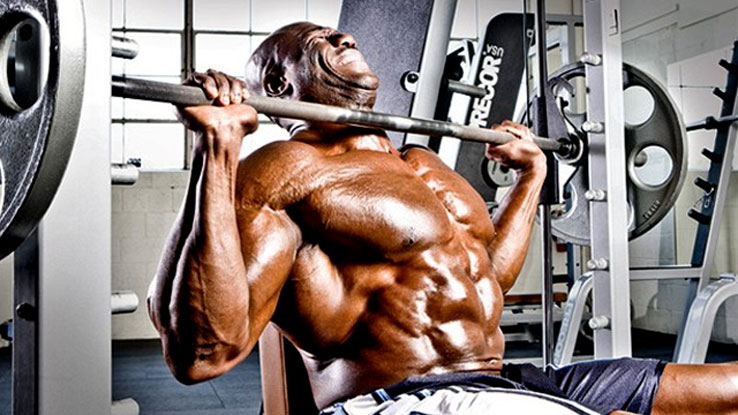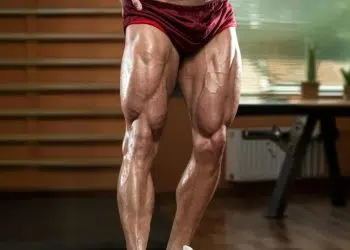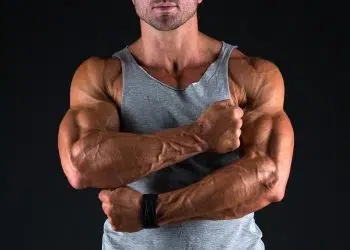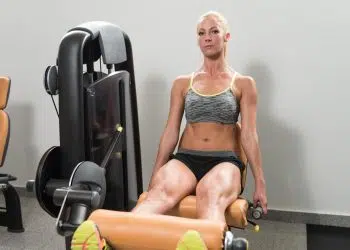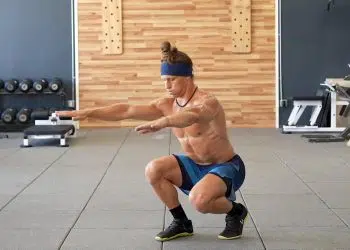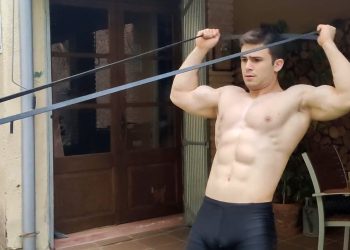Smith machine training is one of the most divisive topics in fitness. On the one hand, some trainers say Smith machines are non-functional and pointless. On the other hand, many of the best bodybuilders in history have used Smith machines, providing a ton of anecdotal evidence supporting their effectiveness.
So – who’s right?
As a veteran personal trainer with over 30 years of professional experience, I believe the Smith machine is a valid training tool. My point of view is supported by a meta-analysis published on PubMed, which suggests that you can build muscle and strength with a Smith machine (1).
However, whether Smith machine training is right for you depends on your goals.
For example, if you are a powerlifter training for your next meet, freeweight barbell squats, bench presses, and deadlifts should make up the bulk of your training. In contrast, if you are a bodybuilder looking to maximize muscle growth, Smith machine squats, bench presses, rows, and shoulder presses could be great options for you.
Level Up Your Fitness: Join our 💪 strong community in Fitness Volt Newsletter. Get daily inspiration, expert-backed workouts, nutrition tips, the latest in strength sports, and the support you need to reach your goals. Subscribe for free!
Of course, some people can’t even make these choices. After all, not all gyms have Smith machines, and you probably won’t have access to one if you work out at home.
The good news is that there are plenty of similarly effective alternatives to the most popular Smith machine exercises, so there is no need to worry about missing out if you don’t have one.
In this article, I reveal accessible alternatives to some of the most popular Smith machine exercises.
The Best Alternatives to 9 Popular Smith Machine Exercises
No Smith machine? No problem! The next time you see a Smith machine exercise in your training program, just do one of the following movements instead. Each one works the same muscles and is every bit as effective. So, no more Smith machine FOMO!
1. Original Exercise: Smith Machine Squats
Alternative: Stability Ball Wall Squat
Target muscles: Quadriceps, gluteus maximus, hamstrings.
Smith machine squats require less balance and coordination than conventional barbell squats. Also, placing your feet slightly in front of you emphasizes your quads and glutes while reducing hamstring engagement. You can achieve a similar effect with a stability ball and a pair of dumbbells.
Steps:
- Place a stability ball between your lower back and a wall.
- Hold a dumbbell in each hand. Brace your core.
- Move your feet so they’re shoulder-width apart and slightly in front of your hips.
- Bend your legs and squat down until your thighs are parallel to the floor.
- Drive your feet into the floor and stand back up.
- Continue for the desired number of reps.
2. Original Exercise: Smith Machine Bench Press
Alternative: Dumbbell Floor Press
Target muscles: Pectoralis major, deltoids, triceps.
The Smith machine bench press is one of the most popular exercises in most gyms. Not only is it an excellent chest builder, but it’s also considerably safer than the freeweight barbell version, especially for solo exercisers. The dumbbell floor press is also a safe lift for those who prefer to train alone.
Steps:
- Lie on the floor with a dumbbell in each hand, arms straight. Bend your legs and plant your feet on the floor. Press your shoulders down and back.
- Bend your elbows and lower the weights down until your upper arms lightly touch the floor.
- Press the dumbbells back up and repeat.
- Drop the dumbbells out to the side if you cannot complete a rep.
3. Original Exercise: Smith Machine Shoulder Press
Alternative: Scrape-the-Rack Barbell Press
Target muscles: Deltoids, triceps.
Smith machine shoulder presses negate the need to balance a barbell, which leaves you free to focus on lifting and lowering the weight to failure. As such, this is an excellent exercise for deltoid and triceps size. Scrape-the-rack barbell presses offer many of the same advantages without needing a Smith machine. It’s also much more shoulder-friendly.
Steps:
- Place a barbell on the hooks of a squat rack set to about shoulder height.
- Grip the bar with an overhand, slightly wider than shoulder-width grip.
- Stand in a staggered stance and lean into the bar.
- Push the bar above your head while pressing it against the squat rack.
- Lower the barbell and repeat.
- You can also do this exercise seated.
- Please note: This exercise will probably scratch your squat rack and barbell.
4. Original Exercise: Smith Machine Bent-Over Row
Alternative: Barbell Pendlay Row
Target muscles: Latissimus dorsi, biceps.
Bodybuilders have a saying – if you want to grow, you have gotta row. That’s because exercises like bent-over rows are so effective for building muscle and strength. Smith machine bent-over rows are a popular exercise because they’re relatively low-back friendly. Pendlay rows are similarly kind to your lower back.
Level Up Your Fitness: Join our 💪 strong community in Fitness Volt Newsletter. Get daily inspiration, expert-backed workouts, nutrition tips, the latest in strength sports, and the support you need to reach your goals. Subscribe for free!
Steps:
- Place a barbell on the floor. Use full-sized bumper plates or put it on blocks so it’s about mid-shin height.
- Stand behind the bar so your toes are under it. Hinge forward and hold the bar with an overhand slightly wider than shoulder-width grip.
- Without using your legs for assistance, bend your arms and row the bar off the floor and up to your lower chest.
- Lower the weight back to the floor, reset your core and grip, and repeat.
5. Original Exercise: Smith Machine Good Morning
Alternative: Banded Good Morning
Target muscles: Gluteus maximus, hamstrings, erector spinae.
Good mornings are so-called because, when you do them, you look a bit like you are bowing to greet someone. Smith machine good mornings are especially popular because they don’t involve any balance, so you can concentrate on pushing your posterior chain to its limit. Resistance band good mornings are an excellent alternative for home workouts.
Steps:
- Stand on the center of a loop-type resistance band.
- Squat down, hook the band over your neck, and hold it at about mid-chest height.
- Stand upright with your feet about shoulder-width apart, knees slightly bent. Brace your core.
- Push your hips back and hinge forward. Lean over as far as you can without rounding your lower back.
- Drive your hips forward and stand up.
- Continue for the prescribed number of reps.
6. Original Exercise: Smith Machine Shrugs
Alternative: Trap Bar Shrugs
Target muscles: Trapezius, forearms.
Shrugs are a must-do exercise if you want bigger, more powerful-looking traps. Many lifters favor the guided action of Smith machine shrugs, as they allow you to lift heavy loads in comparative safety. Trap bar shrugs can work just as well and actually put your limbs in a more comfortable position.
Steps:
- Load your trap bar and stand inside the handles.
- Squat down and grip the handles with a neutral, palms-in grip. Brace your core, drop your hips, and lift your chest.
- Drive your feet into the floor and stand up.
- Shrug your shoulders as high as possible. Keep your arms straight, and do not use your legs for assistance.
- Lower your shoulders and repeat.
- Place the bar back on the floor on completion of your set.
7. Original Exercise: Smith Machine Reverse Lunges
Alternative: Dumbbell Reverse Deficit Lunges
Target muscles: Quadriceps, gluteus maximus, hamstrings.
Smith machine reverse lunges are one of my favorite leg exercises for hypertrophy. They really nail the quads, glutes, and hamstrings, and their stable nature means you can push your muscles to failure in complete safety. The good news is that you can achieve a similar effect with dumbbell reverse deficit lunges – another of my favorite leg exercises.
Steps:
- Stand on a 4 to 6-inch high platform, e.g., a bumper plate or aerobic step box top. Hold a dumbbell in each hand.
- Take a large step back, bend your legs, and lower your rearmost knee down to within an inch of the floor.
- Push off your back leg and return to your platform.
- Repeat with the other leg.
- Alternate legs for the required number of reps.
8. Original Exercise: Smith Machine Calf Raise
Alternative: Single-Leg Calf Raise
Target muscles: Gastrocnemius, soleus.
If your gym doesn’t have a dedicated calf raise machine, you can train your lower legs using a Smith machine. But what if you don’t have one of those, either? Single-leg calf raises provide a straightforward way to work your calves, and the unilateral nature of this exercise is good for improving muscle balance and ankle stability.
Steps:
- Stand with the ball of one foot on the edge of a sturdy step. Use your hands for balance, e.g., by bracing them against a wall or holding a handrail.
- Lower your heel as far as possible down toward the floor. Get a good stretch in your calf.
- Next, rise up as high as possible onto your tiptoes.
- Alternate between these two positions for the required number of reps.
- Make this exercise more challenging by holding a dumbbell in one hand.
9. Original Exercise: Smith Machine Incline Press
Alternative: Incline Dumbbell Hex Press
Target muscles: Pectoralis major, deltoids, triceps.
Smith machine incline presses are one of the best ways to build a more muscular upper chest. Upper pec mass is critical for an aesthetically pleasing chest. Incline dumbbell hex presses are a similarly beneficial exercise, and they’re considerably more shoulder-friendly, so talk about a win-win!
Steps:
- Set the backrest on an adjustable bench to around 20 to 30 degrees. Lie on the bench with a dumbbell in each hand.
- Hold the weights on your chest and forcefully press them together.
- Maintaining the upward pressure, push the dumbbells up to arm’s length above your chest.
- Lower the dumbbells and repeat.
- Despite the name, you can perform this exercise using round as well as hex dumbbells.
Closing Thoughts
Smith machines have been around for over 70 years. Invented and popularized by fitness guru Jack LaLanne, Smith machines are a gym staple, and many bodybuilders and exercisers enjoy using them.
Sure, Smith machine training is not as functional as freeweights, and strength built on a Smith machine doesn’t transfer well to the same exercise done with a barbell. However, for building muscle in a safe, stable environment, Smith machines are hard to beat.
That said, no type of training is compulsory, and you don’t have to use a Smith machine if you don’t want to. So, there is no need to feel you are missing out if you don’t have access to one. Just use the Smith machine exercise alternatives in this article to keep your training on track.
Related: How Much Does a Smith Machine Bar Weigh?
References:
- Haugen ME, Vårvik FT, Larsen S, Haugen AS, van den Tillaar R, Bjørnsen T. Effect of free-weight vs. machine-based strength training on maximal strength, hypertrophy, and jump performance – a systematic review and meta-analysis. BMC Sports Sci Med Rehabil. 2023 Aug 15;15(1):103. doi: 10.1186/s13102-023-00713-4. PMID: 37582807; PMCID: PMC10426227.

